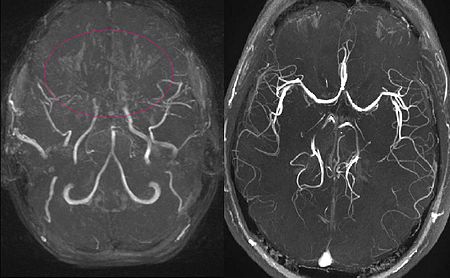Moyamoya Disease: Difference between revisions
Wendy Walker (talk | contribs) No edit summary |
Wendy Walker (talk | contribs) No edit summary |
||
| Line 7: | Line 7: | ||
Moyamoya Disease is a disorder of some of the blood vessels in the brain: the internal carotid arteries, and the arteries which branch from them. It is a rare cause of Stroke and TIAs. | Moyamoya Disease is a disorder of some of the blood vessels in the brain: the internal carotid arteries, and the arteries which branch from them. It is a rare cause of Stroke and TIAs. | ||
[[File:MRA Moya-moya-disease.JPG|alt=2 images, both MIP reconstructed MR angiographies; one is that of an 11 year old girl with Moyamoya Disease, which shows the characteristic occluded cranial arteries, and the other image shows a healthy subject for comparison. | [[File:MRA Moya-moya-disease.JPG|alt=2 images, both MIP reconstructed MR angiographies; one is that of an 11 year old girl with Moyamoya Disease, which shows the characteristic occluded cranial arteries, and the other image shows a healthy subject for comparison.|The image on the left: MIP reconstructed MR angiography of a 11 year old girl with Moyamoya Disease. The image on the right: a healthy subject for comparison. |frame]] | ||
It can also be referred to as Progressive Intracranial Occlusive Arteropathy, or Progressive Intracranial Arterial Occlusion. | It can also be referred to as Progressive Intracranial Occlusive Arteropathy, or Progressive Intracranial Arterial Occlusion. | ||
Revision as of 18:45, 18 April 2024
Clinically Relevant Anatomy[edit | edit source]
Moyamoya Disease is a disorder of some of the blood vessels in the brain: the internal carotid arteries, and the arteries which branch from them. It is a rare cause of Stroke and TIAs.
It can also be referred to as Progressive Intracranial Occlusive Arteropathy, or Progressive Intracranial Arterial Occlusion.
Mechanism of Injury / Pathological Process
[edit | edit source]
The affected arteries become increasingly constricted with time, and a collateral circulation develops around the constricted arteries to compensate for the blockages. The condition is an idiopathic, non-inflammatory, non-atherosclerotic progressive vaso-occlusive disease involving the terminal supraclinoid internal carotid arteries and circle of Willis.
Clinical Presentation[edit | edit source]
The patient often presents either:
- in early childhood, aged around 5 years (two-thirds of patients) OR
- in adults in their 30s or 40s (one-third of patients)
In children, hemispheric ischaemic strokes are the most common presentation; in adults haemorrhage from the abnormal vessels is more common[1].
Stroke or Transient Ischaemic Attack are the most common presentations, although some patients present with headaches or seizures[2].
Diagnostic Procedures[edit | edit source]
Outcome Measures[edit | edit source]
add links to outcome measures here (see Outcome Measures Database)
Management / Interventions
[edit | edit source]
add text here relating to management approaches to the condition
Differential Diagnosis
[edit | edit source]
add text here relating to the differential diagnosis of this condition
Resources
[edit | edit source]
add appropriate resources here
References[edit | edit source]
- ↑ Duan, Lian; Bao, Xiang-Yang; Yang, Wei-Zhong; Shi, Wan-Chao; Li, De-Sheng; Zhang, Zheng-Shan; Zong, Rui; Han, Cong; Zhao, Feng; Feng, Jie (2012). "Moyamoya Disease in China". Stroke. 43 (1): 56–60.
- ↑ Kleinloog, R (May 2012). "Regional differences in incidence and patient characteristics of moyamoya disease: a systematic review". J Neurol Neurosurg Psychiatry. 83 (5): 531–6.







